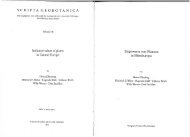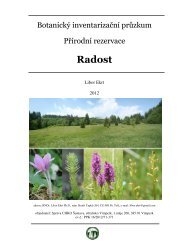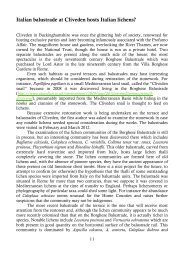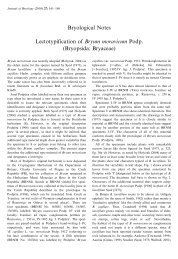Bryophyte flora of the Czech Republic: updated checklist and Red ...
Bryophyte flora of the Czech Republic: updated checklist and Red ...
Bryophyte flora of the Czech Republic: updated checklist and Red ...
You also want an ePaper? Increase the reach of your titles
YUMPU automatically turns print PDFs into web optimized ePapers that Google loves.
836 Preslia 84: 813–850, 2012<br />
12 Ochyra & Bednarek-Ochyra (2011) recently provided arguments for replacing <strong>the</strong> name Bryum pallescens<br />
Schleich. ex Schwägr. with <strong>the</strong> older name B. boreale (F. Weber et D. Mohr) Funck.<br />
13 Bryum gemmiferum was first reported from <strong>the</strong> <strong>Czech</strong> <strong>Republic</strong> by Soldán & Kučera (2004) but fur<strong>the</strong>r<br />
records continue to be added.<br />
14 Holyoak & Hedenäs (2006) demonstrate <strong>the</strong> morphological intergradation between Bryum pseudotriquetrum<br />
var. pseudotriquetrum <strong>and</strong> var. neodamense <strong>and</strong> non-monophyly <strong>of</strong> <strong>the</strong> latter taxon.<br />
15 Based on an unpublished revision <strong>of</strong> JK’s collections by O. M. Afonina, <strong>the</strong> <strong>Czech</strong> collections <strong>of</strong><br />
‘Campylidium sommerfeltii’ probably represent a different taxon, closely related to Hypnum pallescens.<br />
‘C. sommerfeltii’ has been distinguished in <strong>the</strong> <strong>Czech</strong> <strong>Republic</strong> only in recent decades, previous authors confused<br />
or merged this taxon with C. calcareum <strong>and</strong> <strong>the</strong> North American C. hispidulum. A revision <strong>of</strong> this complex<br />
is badly needed.<br />
16 Didymodon umbrosus was shown to deserve specific status by Jiménez et al. (2005).<br />
17 Didymodon validus was recognized as a variety <strong>of</strong> D. rigidulus in our previous <strong>checklist</strong> <strong>and</strong> not at all listed by Hill<br />
et al. (2006). Later though, Jiménez (2006) <strong>and</strong> Ochyra et al. (2011) recognized <strong>the</strong> taxon at <strong>the</strong> specific level.<br />
18 The taxonomy <strong>of</strong> Encalypta rhaptocarpa agg. is very unsatisfactory. There is not a good match between <strong>the</strong><br />
development <strong>of</strong> peristome <strong>and</strong> o<strong>the</strong>r characters <strong>of</strong> this species mentioned by Horton (1983), Nyholm (1998)<br />
<strong>and</strong> Mogensen (2001), <strong>and</strong> our application <strong>of</strong> <strong>the</strong> name is thus very tentative.<br />
19 Hradílek (2008) clarified <strong>the</strong> situation with Entosthodon pulchellus that was confused with E. muhlenbergii in<br />
<strong>the</strong> <strong>Czech</strong> <strong>Republic</strong>. Both historical herbarium records <strong>and</strong> recent collections were cited.<br />
20 We consider that Fissidens bambergeri is a good, although only rarely accepted species that cannot be lumped<br />
with F. viridulus. The distinctness <strong>of</strong> two <strong>Czech</strong> <strong>and</strong> several o<strong>the</strong>r central-European populations has been<br />
observed for years, although no molecular methods have yet been applied to resolve <strong>the</strong> genetic background<br />
<strong>and</strong> <strong>of</strong> course <strong>the</strong> application <strong>of</strong> <strong>the</strong> pattern to existing types may prove problematic.<br />
21 We have applied <strong>the</strong> name Fissidens limbatus only to plants that narrowly correspond to <strong>the</strong> original description<br />
by Sullivant. In this concept, F. limbatus is an extremely rare <strong>and</strong> endangered species in <strong>the</strong> <strong>Czech</strong> <strong>Republic</strong><br />
<strong>and</strong> should be evaluated similarly to F. bambergeri. An eventual broadening <strong>of</strong> <strong>the</strong> concept to include<br />
F. crispus Mont., as understood by Hill et al. (2006), would create problems in delimiting F. pusillus,however<br />
without an underst<strong>and</strong>ing <strong>of</strong> <strong>the</strong> underlying genetic pattern <strong>the</strong> problem cannot be resolved.<br />
22 We are not convinced <strong>of</strong> <strong>the</strong> value <strong>of</strong> infraspecific taxa within Fontinalis antipyretica, distinguished pragmatically<br />
by Hill et al. (2006). Shaw & Allen (2000) show that <strong>the</strong> subsp. gracilis (Lindb.) Kindb. is paraphyletic<br />
<strong>and</strong> a similar pattern can be expected for o<strong>the</strong>r infraspecific taxa. Never<strong>the</strong>less, both <strong>the</strong> subsp. gracilis <strong>and</strong><br />
subsp. kindbergii (Renauld et Cardot) Cardot are reported in <strong>the</strong> <strong>Czech</strong> <strong>Republic</strong> but <strong>the</strong> underlying genetic<br />
differences have never been studied.<br />
23 Grimmia dissimulata was newly reported for this country by Kučera (in Ellis et al. 2010).<br />
24 We agree with <strong>the</strong> authors <strong>of</strong> <strong>the</strong> European <strong>checklist</strong> that <strong>the</strong> radical treatment <strong>of</strong> V<strong>and</strong>erpoorten (2004), which<br />
merged all European species <strong>of</strong> Hygroamblystegium with H. varium, needs to be supported by a more extensive<br />
study. In a later study V<strong>and</strong>erpoorten & Hedenäs (2009) admit H. humile is a variety <strong>of</strong> H. varium but<br />
maintain <strong>the</strong> full synonymy <strong>of</strong> H. fluviatile <strong>and</strong> H. tenax with H. varium, particularly with respect to <strong>the</strong> situation<br />
in North America.<br />
25 Hypnum cupressiforme var. julaceum Brid., listed in our previous <strong>checklist</strong>s, is not recognized by Hill et al.<br />
(2006). As we could only doubtfully identify some <strong>of</strong> our plants as <strong>of</strong> this variety, we have not included it in<br />
this list.<br />
26 Hypnum cupressiforme var. heseleri was recently detected at one locality in sou<strong>the</strong>rn Moravia (Košnar &<br />
Kučera in prep.).<br />
27 Conflicting evidence was presented by V<strong>and</strong>erpoorten et al. (2003) <strong>and</strong> Frahm (2005) about distiguishing<br />
Leucobryum albidum (Brid. ex P. Beauv.) Lindb. (which is an older name) from L. juniperoideum. Therefore, we<br />
pragmatically retain <strong>the</strong> more narrowly defined concept <strong>of</strong> both taxa until a more convincing conclusion is reached.<br />
28 Eurhynchium pumilum was transferred to a newly established monotypic genus Microeurhynchium by<br />
Aigoin et al. (2009).<br />
29 G<strong>of</strong>finet et al. (2004) <strong>and</strong> Sawicki et al. (2010) argue for accepting <strong>the</strong> genus Nyholmiella as distinct from<br />
Orthotrichum. Accepting this probably well-defined lineage however renders <strong>the</strong> rest <strong>of</strong> Orthotrichum<br />
paraphyletic, which will necessitate <strong>the</strong> recognition <strong>of</strong> fur<strong>the</strong>r genera within Orthotrichum s.l. in <strong>the</strong> future.<br />
30 Taxonomy <strong>of</strong> Hygrohypnum s.l. partially settled after Oliván et al. (2007) <strong>and</strong> Ignatov et al. (2007) reached<br />
similar conclusions based on different datasets. The only serious conflict is over Hygrohypnum duriusculum,<br />
which was resolved within Hygrohypnella (sequenced specimen from Caucasus) by Ignatov et al., but within<br />
Ochyraea (sequenced specimen from Norway) by Oliván et al. Our plants seem to match <strong>the</strong> concept <strong>of</strong><br />
Oliván et al., which is supported by <strong>the</strong> nrITS sequence <strong>of</strong> one <strong>Czech</strong> specimen (JQ814784). Never<strong>the</strong>less, we










